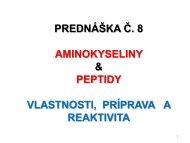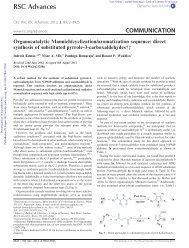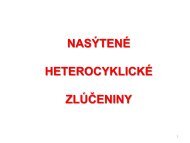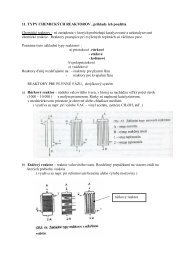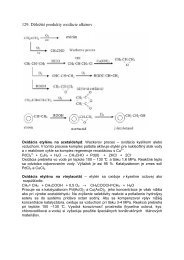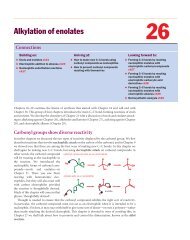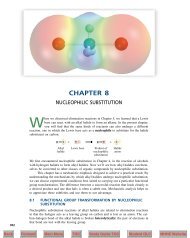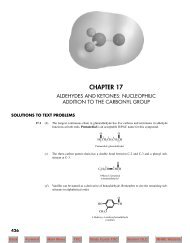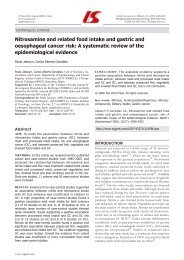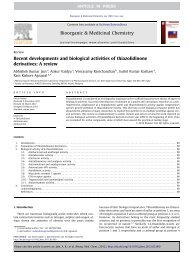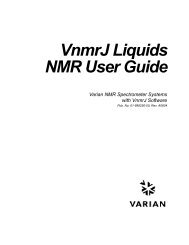You also want an ePaper? Increase the reach of your titles
YUMPU automatically turns print PDFs into web optimized ePapers that Google loves.
<strong>13</strong>.<strong>13</strong>.1.1.2.1.2 Method 2:<br />
From Diazoalkanes and Imines, Oximes, or Diarylazines<br />
The 1,3-dipolar cycloaddition of diazoalkanes to C=N bonds is a general method for the<br />
synthesis of 4,5-dihydro-1H-1,2,3-triazoles and 1H-1,2,3-triazoles (Scheme 22). [4] It is an especially<br />
useful method for the regioselective preparation of 1H-1,2,3-triazoles with bulky<br />
substituents in positions 1 and 5. Imines are the most versatile C=N system to be used in<br />
this method, but oximes and diarylazines can also be used.<br />
Scheme 22 Addition of Diazoalkanes to Imines [55,56]<br />
R 1<br />
R 2<br />
50<br />
NR 3<br />
+ R 4 CHN 2<br />
<strong>13</strong>.<strong>13</strong>.1.1.2.1.2.1 Variation 1:<br />
From Diazoalkanes and Imines<br />
R<br />
N<br />
N<br />
N<br />
4<br />
R3 R2 R1 4,5-Dihydro-1H-1,2,3-triazoles 51 are the expected products from the cycloaddition reaction<br />
of imines 50 with diazoalkanes but in some cases they spontaneously aromatize to<br />
the corresponding triazoles. When the 4,5-dihydro-1H-1,2,3-triazoles are the isolated<br />
products they can be converted into triazoles by a large number of alternative procedures<br />
(see Section <strong>13</strong>.<strong>13</strong>.1.3).<br />
The addition of diazoalkanes (especially diazomethane) to imines, to give 4,5-dihydro-1H-1,2,3-triazoles<br />
51, is very well studied. [4] In general it is favored by the presence of<br />
electron-withdrawing substituents in the imine, especially on an N-aryl moiety. [55,56]<br />
Though kinetic investigations of this reaction show that it follows essentially a concerted<br />
process and is not generally dependent on solvent polarity, a sizable increase in rate is<br />
noticed in the presence of protic solvents such as water or alcohols. [57] For example, while<br />
reaction of diazomethane with N-benzylideneaniline (52,Ar 1 =Ar 2 = Ph) does not occur in<br />
dry ether, it does occur in aqueous dioxane giving the 4,5-dihydro-1H-1,2,3-triazole 53<br />
(Ar 1 =Ar 2 = Ph) in 53% after eight days (Scheme 23). [55] This solvent system can be successfully<br />
used for the preparation of 5-hetaryl-substituted 4,5-dihydro-1H-1,2,3-triazoles of<br />
type 53 (Ar 1 = 2- or 3-pyridyl, 2-quinolyl). [58,59] Triethylaluminum and other aluminum<br />
complexes have been used as catalysts in the reaction of diazomethane with imines. [50]<br />
Scheme 23 Addition of Diazomethane to Diarylimines [58]<br />
Ar 1<br />
52<br />
N<br />
Ar 2<br />
+ CH2N 2<br />
FOR PERSONAL USE ONLY<br />
430 Science of Synthesis <strong>13</strong>.<strong>13</strong> 1,2,3-<strong>Triazoles</strong><br />
dioxane, H2O (cat.)<br />
rt, 2−8 d<br />
51<br />
Ar 1<br />
53<br />
N<br />
N<br />
N<br />
Ar2 Diazomethane undergoes addition to hexafluoroacetone imines 54 to give 4,5-dihydro-<br />
1H-1,2,3-triazoles 55 as the sole product or to give mixtures of 4,5-dihydro-1H-1,2,3-triazoles<br />
55 and 56 (the latter produced as a result of the addition of diazomethane to the<br />
C=C bond) (Scheme 24). [60]<br />
A. C. TomØ, Section <strong>13</strong>.<strong>13</strong>, Science of Synthesis, 2004 Georg Thieme Verlag KG



